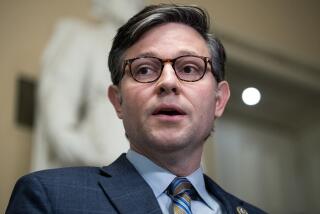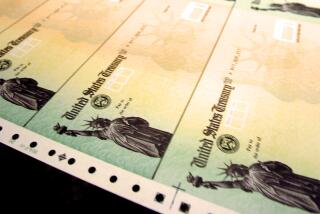Census Study Finds Benefits Keep Elderly From Poverty
- Share via
WASHINGTON — Nearly half the nation’s elderly would be living below the poverty line without Social Security and other government payments, according to a Census Bureau study released Tuesday.
The study, which assessed poverty rates under a variety of hypothetical definitions, found that the nation’s reported 1986 poverty rate of 13.6% would have been 2 percentage points lower using a definition that excluded income and payroll taxes but included non-cash government benefits not factored into the current standard.
For 1986, the poverty line was $5,701 for a single person, $5,255 for a single, elderly person, and $11,203 for a family of four.
Estimated Medicare, Medicaid Values
The study was the first of a series of experimental reports compiling benefit and tax data that previously had been handled in separate reports. It also was the first time the Census Bureau had estimated monetary values to recipients of non-cash benefits such as Medicare and Medicaid.
The government’s current definition of income includes all cash pre-tax income except capital gains, including government benefits such as Social Security, veterans’ benefits, unemployment and workers’ compensation insurance and public assistance.
Using the current definition, the overall national poverty rate in 1986 was 13.6%. Among whites it was 11%, among blacks 31.1% and among Latinos 27.3%.
If the definition were amended to include non-cash benefits and capital gains, the overall poverty rate in 1986 would have been 11.6%, the Census Bureau reported. Among whites it would have been 9.4%, among blacks 25.8% and among Latinos 23.5%.
Variety of Possible Income Definitions
The new study listed hypothetical poverty rates under a variety of possible income definitions, including one used in the private sector: income excluding cash-paid government benefits such as Social Security while adding employer-provided health benefits.
Comparing the poverty rate among the elderly using the current government standard and the private-sector formula shows the striking effect of Social Security. Using the government formula, 12.4% of those over 65 years old lived in poverty in 1986. Under the private-sector definition that excludes Social Security, the poverty rate for that age group was 48.5%.
In addition to assessing the effect of various government programs and definitions of income on poverty, the study listed an index of income concentration under each experimental definition.
Under the official definition of income, the Census Bureau reported that aggregate household income in 1986 was $2.75 billion, with a median household income of $24,897. The index of income concentration showed that the bottom 20% of households received 3.8% of total income while the top 20% received 46.1%.
If all government benefits were subtracted from the income definition and employer-paid health benefits were included, 52.4% of all income was received by the top 20% of households and just 1% by the bottom 20%.
More to Read
Sign up for Essential California
The most important California stories and recommendations in your inbox every morning.
You may occasionally receive promotional content from the Los Angeles Times.













